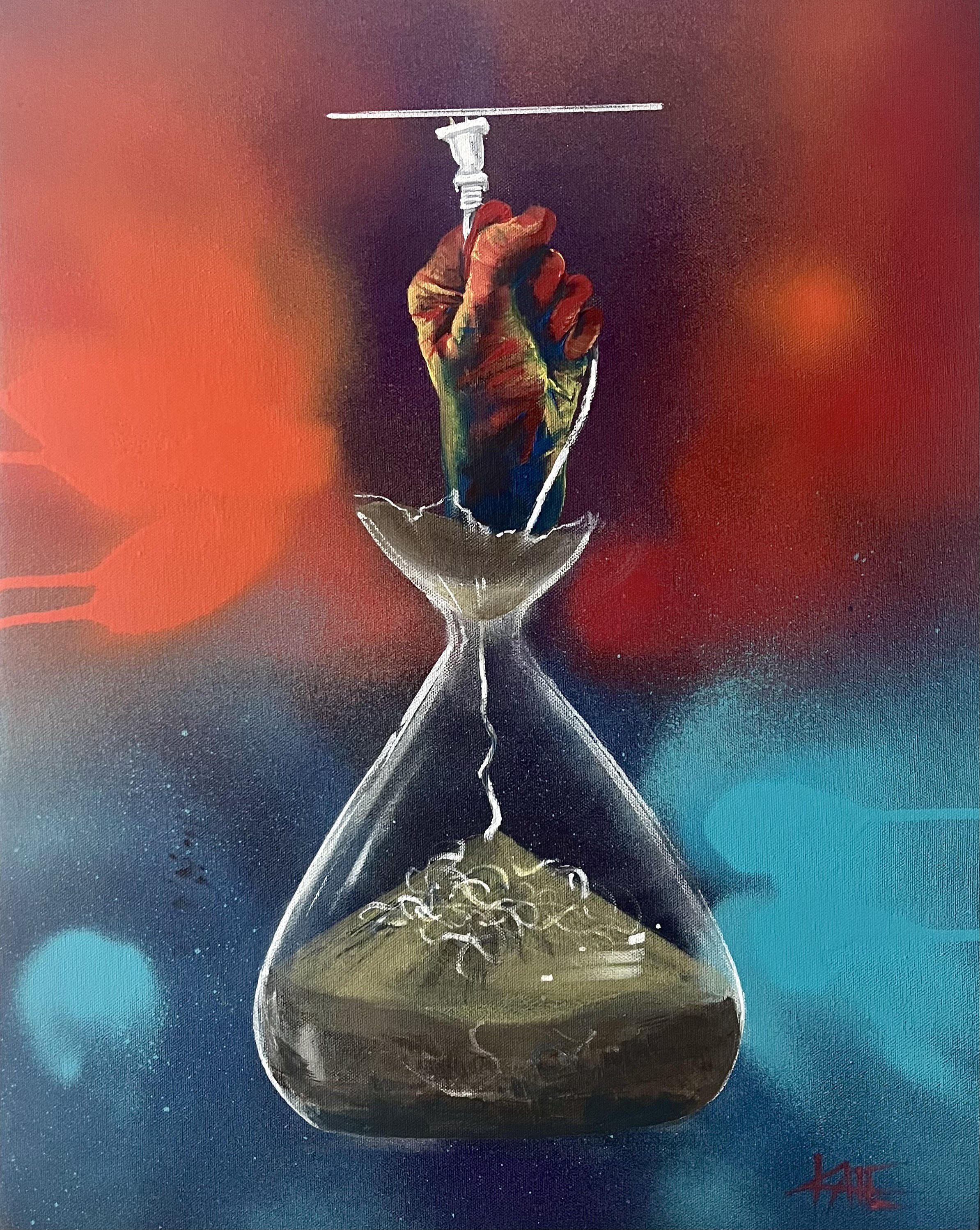It’s Time To Make Time
KatieLorraine
“It’s basically acting before you’re allowed to doubt your movements.”
Interview by C. VanWinkle
October 19, 2021
Would you please begin by describing the piece that responded to?
It was a very heavenly image, surrounded by mirrors, with ladders and doors and different gateways. That made me really think about the mind, life and death, and the hard process of life that we don’t love to face or talk about or deal with. And it was circling around showing different letters, spelling out “Let me go” and “I waved goodbye.” It felt like somebody was trapped in their body, watching someone mourn them, trying to get them to move on with their life. Like they’re wasting their time or they’re not enjoying their time. Everything circled back to time for me. So that’s what I was watching, it circling around, the words coming through. And there was a semblance of fire with lighting and orange paper and candles and things. Different suggestions of what could be an afterworld or limbo or being trapped somewhere.
I really like that your mind went somewhere so specific.
Yeah, absolutely. I like that about this entire process. Everybody sees things so differently. We see in different filters, we think differently. So you really get a very interesting dynamic when you’re showing it to one person and then passing on the paintings.
What was your first impression when you saw the diorama?
There were some strange, muffled noises in the background. I could kind of make out a couple words, but it was creepy! That first few seconds, I was creeped out. It reminded me of Poltergeist or something. As it went on, it just became so sad. It felt like this really hard experience that I think we’ve all had in our lives at some point, whether it’s losing someone or having someone really sick in your family or going through Alzheimer’s and dementia, dealing with mental health. We’ve all shared that experience. So it felt very depressing after the initial shock of feeling really creeped out.
I’ve been looking forward to getting your take on this diorama because this piece is so open to interpretation.
Yeah. It definitely read to me like somebody being trapped in a place of isolation, whether that’s being in a coma or having mental health issues or memory loss or just feeling completely alone, trying to have the people around them move on with their lives and live their best life and not do what they did with their time.
So what happened next? Can you walk me through your process?
I was going to talk with my mom that day, so I gave her a quick call. We were talking about our life experiences with a lot of illness, like Alzheimer’s, which I had faced with my grandmother and a few friends. I teach painting to people with Alzheimer’s and dementia, and different mental capacities or limitations. We were discussing what that feels like, what that is, how you would represent that in your mind. Just kind of walking myself through a conversation, which I like to do when I’m thinking of paintings.
Artwork by KatieLorraine
Then I hung up and I was thinking about time. I’m constantly obsessed with time. I lived my whole 20’s racing around like a maniac, scheduling too much in a day and running back and forth, trying to get things done. And then always feeling like I didn’t make enough time to see friends. I didn’t make enough time to go travel or do this. It was just this constant reminder of time, in every way both positive and negative. That’s what made me think of the hourglass representing the physical form of time. And I wanted to have a hand pulling on the plug. It could look as though you are choosing to stop time, to stop the rush and the madness, and just be present and unplug from whatever mania that you’ve gotten into. I wanted it to be open to interpretation on both levels in that regard. I put the wiring through the sand to represent the mind. The cool, blue colors are the mind that’s just lost and numb and struggling. And the heat coming from the hand is that last grip of strength that you need to pull through these things.
Wow! That is excellent. Was it important to you to stay close to the source material or was that just to trigger an idea to go somewhere else?
I like to try to keep within that frame, within that reference, but it definitely triggered me to go down the wormhole of other things. I tried to keep the simple colors, the fiery feel, and the whimsical background. I tried to incorporate elements of it because I like that it ties it together in a way, even though I don’t really know what it’s about.
You said that you spent your 20’s always rushing around, and now you are a speed painter. Can you describe what speed painting is for me?
[laughs] Yeah, I guess I’m always rushing around! I mostly do live performance paintings. In venues, I will have a large canvas set up and I’ll give myself anywhere from 30 to 90 minutes to complete a piece. It’s inspired by the energy of the audience and the music and whatever artists I’m collaborating with. It’s a lot of fun, and when I’m creating these pieces there, it’s amazing to see the different range of styles that come out from being with different people, different energies, different vibes. I also do 20 to 30-minute online Instagram lessons, where I’ll just do a live for 30 minutes and paint something photo-realistic and show a couple techniques of how that can be done very quickly. When I was younger, my brother and I would sit and speed draw when we were watching TV. You’d see a character come up and you’d try and draw-it-as-fast-as-you-could before they’re off the screen. It’s a huge part of my life and my career now.
That sounds like a lot of fun.
It is!
If you are working so fast and trying to get it finished in a little window of time, how do you know when it’s finished? That could be a question for any painter, but especially a speed painter.
That’s a really good question. And to be honest, half the time you just feel it. You think, Okay, I’m done. And the other half of the time I will step back, talk to the people in the room, come back to it, and maybe add something else and then I’m done. But it’s really down to a feeling, being able to let go and not hit perfection. For the longest time in my career, I was always striving to make the perfect painting. And I would get frustrated. I would start over and over and over. You know the process with artists; you just get insane, you get in your head. Now I find that the less I do, the more it says. And the quicker I can pull myself back and walk away, the happier I am with the piece.
Do you collaborate often? Do you often work from prompts or with other painters?
A LOT. I work with different musicians, different painters, artists, poets, writers, drama, music producers, like all artists. I love love love collaboration. I think it’s the most important way to express yourself. And I think it really draws out so much more in creative people when we share, especially with someone that we have no concept of their entire genre. It just opens up your mind so much more. I work with artists who are extremely experienced and give me advice, and I work with artists who are brand new, and I give them advice and boost them up and help them out. I think it’s a constant collaboration.
It’s no wonder Bait/Switch caught your eye. This seems like it’s exactly in your wheelhouse! How does this painting relate to the rest of your work?
If you were to look at the entirety of my portfolio, you would think that seven different artists were involved. I think it relates in that it’s a very raw and open piece of my emotion, whether that’s sometimes painting things that are super bubbly and happy or dark and sad. But also, I have a theme of different spray paint mixed with acrylic. So that, across the board, you can see and know that’s a Katie Lorraine. I do a lot of graffiti murals as well in the city (of Toronto) and I think that is kind of my mark.
It is extremely rare that we have anyone who works as fast as you do. It’s most common that somebody will take most of, all of, or even a little more than those two weeks.
I know, I get that often! I get shit done.
I was told that you’re a speed painter and I said, “I don’t know what that means, but I’m going to send her this.” And then I found out what that means.
It’s basically acting before you’re allowed to doubt your movements.
I love that. That’s like National Novel Writing Month. You don’t have time to dilly-dally. So you just have to bang it out. I could benefit from that advice.
I have.
Speaking of advice, do you have any for someone else approaching this project for the first time?
I would say give yourself a couple of hours to process. Watch the video, process, and put it out raw. I’m just saying for your initial idea, for the initial sketch. Watch, or look at the painting, no music, no interruptions. Give yourself that time to just be in your mind and really see how you feel.
Call Number: C58VA | C60VA.kaIt
20+ years @katielorraineart is a live performance speed painter, commission based artist, muralist & teacher.




